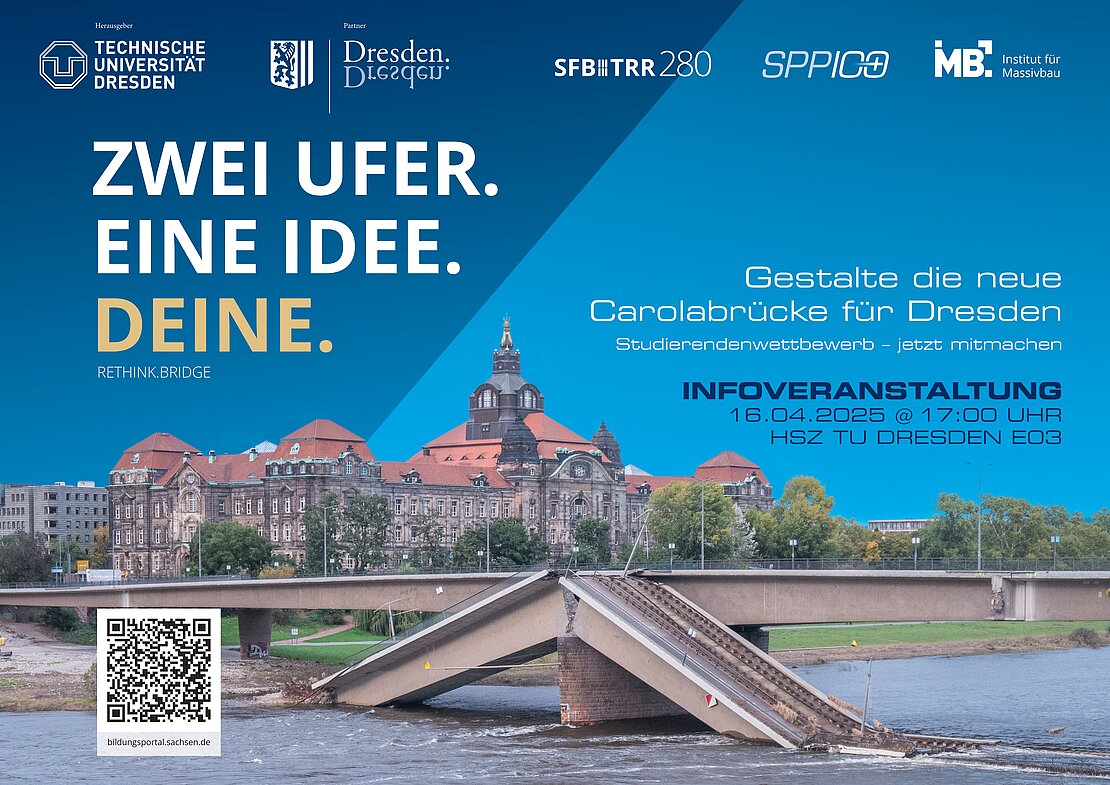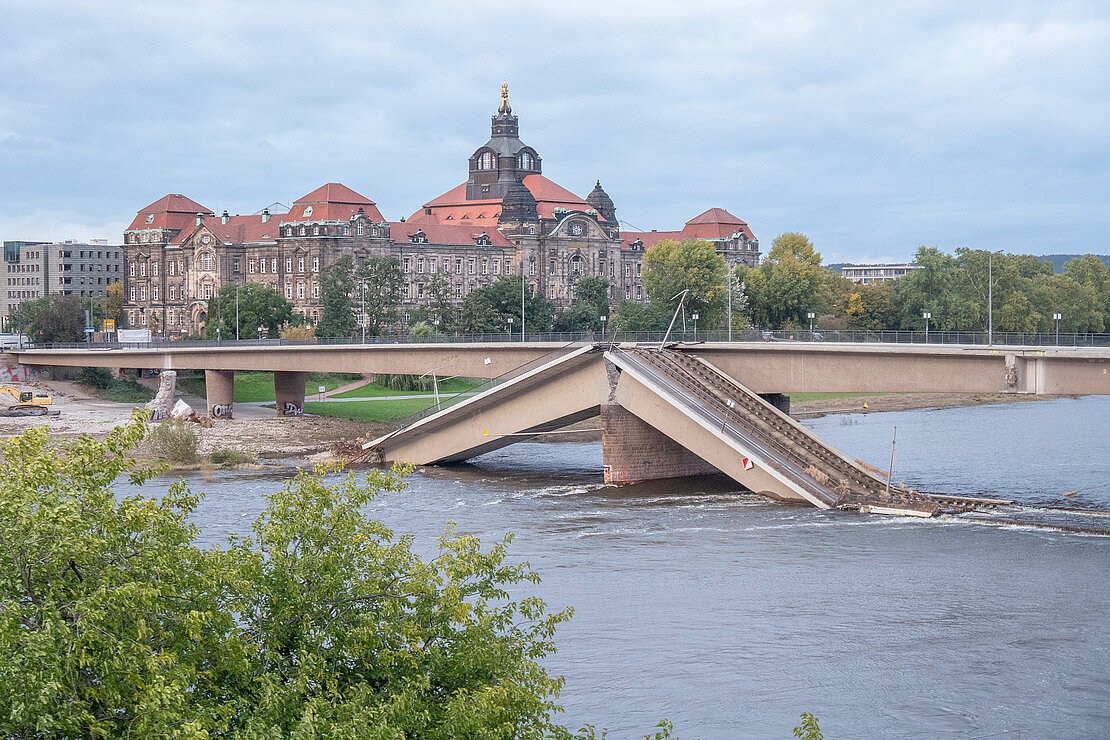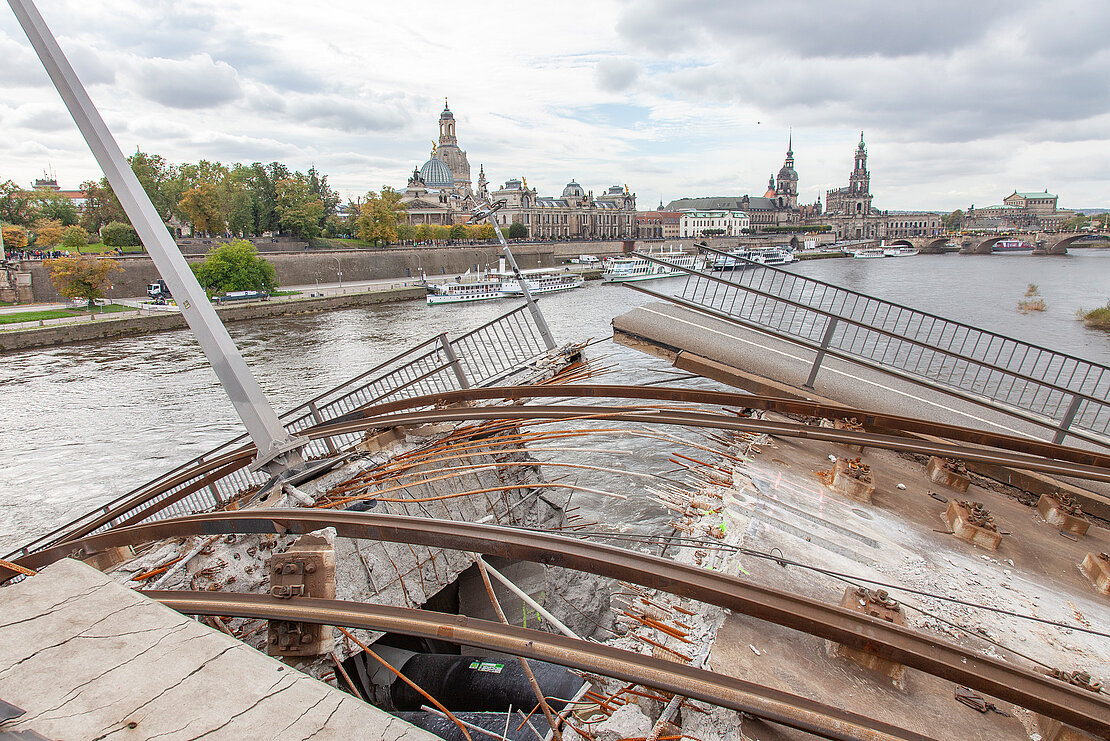Announcement
For the summer semester 2025, the Institute of Concrete Structures at TU Dresden, the CRC/Transregio 280 and the priority program SPP 2388, under the patronage of the City of Dresden, are holding a student competition to design a new Elbe crossing at the site of the collapsed Carola Bridge in Dresden.

Präambel
Am 11. September 2024 ereignete sich in Dresden ein unerwarteter Teileinsturz der Carolabrücke, bei dem ein etwa 100 Meter langes Segment des Brückenzugs c in die Elbe stürzte. Glücklicherweise gab es keine Verletzten, jedoch führte dieses Ereignis zu erheblichen Beeinträchtigungen für die Dresdener Stadtbevölkerung. Die Carolabrücke war ein herausragendes Ingenieurbauwerk und eine der zentralen Elbquerungen Dresdens und spielte eine entscheidende Rolle im städtischen Verkehrsnetz. Sie verband die Altstadt mit der Neustadt und wurde täglich von Tausenden genutzt, von Kraftfahrzeugen, Fußgängern, Radfahrenden und öffentlichen Verkehrsmitteln wie Straßenbahnen. Ihre strategisch günstige Lage ermöglichte eine effiziente Verkehrsführung und trug wesentlich zur Entlastung der benachbarten Brücken bei. Seit ihrem Einsturz werden zwangsläufig alternative Routen genutzt, was zu einem erhöhten Verkehrsaufkommen und Verzögerungen auf den anderen Elbquerungen führte.
Untersuchungen zur Einsturzursache ergaben, dass der sukzessive Ausfall von Spanngliedern infolge wasserstoffinduzierter Spannungsrisskorrosion hauptverantwortlich war. Der Schädigungsprozess wurde bereits während der Bauzeit von Ende der 1960er Jahre bis 1971 initiiert und blieb über Jahrzehnte unbemerkt. Aufgrund der umfassenden und fortgestrittenen Schäden ist ein Erhalt der heute noch stehenden Brückenzüge a und b nicht möglich, weshalb ein vollständiger Abriss der Brücke unausweichlich ist. Mit der Entscheidung für den vollständigen Rückbau der Carolabrücke muss auch die Planung einer neuen Elbquerung beginnen.

Aim of the competition
A competition to redesign the Carola Bridge was held back in 1964. The results were publicly exhibited and judged. Around 250 students also gave their opinions on the bridge designs. This competition encouraged innovative approaches and contributed significantly to the design of the structure that was later realized.
In keeping with this tradition, the students themselves will now have the opportunity to contribute their creative and visionary ideas for the new Carola Bridge. We are looking for bold, technically sophisticated, resource-efficient and functional designs that respect both the significance of the location and the history of the crossing while integrating innovative construction methods and technologies. The new bridge should not only meet current and future traffic requirements, but also enrich Dresden's skyline as an architectural landmark. This competition offers a unique opportunity to make a formative contribution to the design of Dresden's cityscape and to continue the tradition of outstanding engineering.

Topic | Task
The task is to design a new Elbe crossing on the site of the collapsed Carola Bridge. The bridge is to connect the two districts of Neustadt and Altstadt for road, bicycle and pedestrian traffic and provide tracks for the streetcars operated by Dresden's public transport company.
The exact route of the structure can be chosen independently within the boundaries of the existing buildings and taking into account the planned and existing infrastructure. The entire design area extends from Rathenau- to Carolaplatz. Attention must be paid to a sensible connection to the existing network of paths and a suitable integration of the Elbe cycle path running along both sides of the Elbe. The bridge can serve as an impulse generator for the further development of the traffic axis St. Petersburger Straße and Albertstraße-Carolaplatz. Particular attention is drawn to the careful inclusion of the supra-regionally significant surroundings, especially the old town.
The focus of the task lies in the development of a constructively interesting and sensible design. The supporting structure should be designed to be efficient and resource-saving. The choice of materials and the construction method are open, whereby material-appropriate and realistic design approaches are assumed. In addition, high demands must be placed on the construction process, as the navigability of the Elbe as an important international waterway must be guaranteed.
The functional division of the bridge for the individual types of traffic or a possible combination is to be worked out freely. The usable widths to be applied can be sensibly and justifiably adjusted as part of the planning process. Existing development studies by the city of Dresden on the design of the Königsufer and St. Petersburger Straße can be taken into account. The structure and the transition to the banks of the Elbe must be designed to be barrier-free. The bank area below the structure may be freely planned. The entire structure must be provided with adequate and attractive lighting.
The height of the danger zone to be kept clear above the Elbe is 7.875 m and applies to a width of 196 m. This height must be guaranteed. The main span with a length of 120 m should preferably be retained. The necessary substructures are to be erected primarily on the foundations of the previous structures.
The following features are given special consideration by the jury and should therefore be urgently taken into account in the design:
- High material efficiency of the supporting structure with sufficient robustness (principles “form follows force” and “form follows function”)
- Ecological use of resources
- Urban integration into the surroundings
- Height adjustment in the terrain
- Sensible external development
- Sustainable operation of the bridge
- Design of the bridge
- Construction method taking into account the concerns of shipping traffic
Competition documents
In addition to the brief, the following documents will be provided by the competition organizers:
- Template for a declaration of eligibility and copyright (.pdf)
- Photos of the surroundings (.jpg)
- Site plan 1:2,500 - Thematic city map of Dresden (.pdf)
- Site plan 1:5,000 - Thematic city map of Dresden (.pdf)
- DTM model of the surroundings (.dxf)
- Cross-section of the prestressed concrete Carola Bridge (1966-1971) (.pdf)
The documents are available for download at the following link:
Opal (LINK)
In addition, a digital terrain model is available via a WMS interface at the following link. The WMS data can be displayed using GIS software.
Opal (LINK)
If access is not possible for you because you do not belong to a Saxon university, you can also have the documents sent to you by e-mail. Proof of university affiliation is required for this.
Dates
The student competition will be announced for the summer semester 2025. The competition documents will be made available to students from 16.04.2025 via Opal (LINK). The following dates are part of the competition:
- 16.04.2025 Information event and provision of the brief
- Announcement via Opal Possibility of a site visit (presence)
- 29.08.2025 Submission of the competition entries
- September 2025 Jury meeting in Dresden
- October 2025 Award ceremony
Further information on consultation opportunities, site visit, jury meeting and award ceremony will be announced in good time before the respective event via Opal (LINK).





